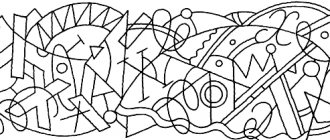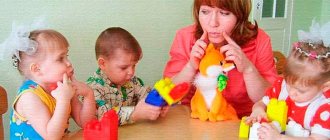The number of children suffering from GSD (general speech underdevelopment) is increasing every year. A similar defect is detected in 70% of babies. It is important to understand that pronunciation defects negatively affect the development of written speech in children of preschool and primary school age. The development of coherent speech in children with special needs development is based on the ability to compose sentences that correspond to their level of development. Linking words in a sentence allows you to express and understand the meaning of what is said. It is the skill of composing lexically and syntactically correct sentences that is the basis of correctional work.
What is ONR
The diagnosis of OHP includes a complex of speech disorders in which the child has not only incorrect articulation, but also problems with comprehending what he hears. To correct the defect, a speech therapist works with preschoolers. Therapy will be more effective the earlier it is started.
A characteristic feature of children diagnosed with general speech underdevelopment is low coherent storytelling skills. The use of speech therapy techniques makes it possible to develop missing skills during the educational and training process in children aged 4–5 years.
Features of speech development of children with mental retardation
Many people study the topic of speech development of children with mental retardation, and the research results are reflected in abstracts and reports. It is known that children with mental retardation have:
- a small supply of information and ideas about the world around us;
- decreased cognitive activity;
- violations of all components of speech;
- decreased formation of mental functions;
- poorly regulated voluntary activity.
Note! A common feature of the coherent speech of children with mental retardation is the difficulty of retelling and telling a story based on a series of plot pictures. Violations of the lexical, grammatical and articulatory structure of speech are also inherent.
How to shape the speech of children with mental retardation
Glukhov’s technique is taken as the basis for the test for differentiating the disorder and determining its degree. The competence of this test is confirmed by numerous studies of students and teachers who include the methodology in the practical part of their diplomas and devote the bulk of the collection of statistical data to it in coursework.
Corrective work on the formation of correct statements in children with mental retardation:
- Formation of clear and clear pronunciation, elimination of defects in sound pronunciation.
- Development of cause-and-effect relationships and the ability to correlate a word and an object (phenomenon, sign or action).
- Increasing vocabulary.
- Eliminating errors in the use of prepositions and case forms.
Note! Enriching children's non-verbal communication is possible through the development of non-verbal means of communication - facial expressions and gestures. Children with mental retardation have poor coordination of facial movements and sluggish articulation, which disrupts the preschooler’s communication with both peers and adults.
Non-verbal means of communication are developed in a playful way - at first all the exercises are shown by the teacher (individually - in front of a mirror or looking “eye to eye", in a group lesson - demonstrating a presentation), followed by joint repetition, and only at the end - an individual demonstration (repetition can be organized exercises in a chain, one after another).
Lesson on speech formation in children
Rules and procedures for speech therapy work
Coherent speech refers to the ability to compose a common sentence or several interconnected phrases to ensure communication and understanding between people. The formation of coherent speech in children with ODD is the basic task of speech therapy correction. It is inextricably linked with the development of thinking. According to E.I. Tikheyeva, without precise thinking it is impossible to learn the skills of combining statements.
It is in the senior preschool period that the child’s thinking changes - his horizons expand, his thinking process improves, new skills appear, and speech is formed.
But the ability to speak is acquired only during communication. Increasing communication skills contributes to the complication of grammatical forms used by a preschooler. If the child has developed the abilities of primitive spoken language, then the passive vocabulary is close to age requirements. He will be able to talk about his friends, relatives or bright events in life.
Correctional classes for preschoolers diagnosed with speech underdevelopment are aimed at:
- improving phonemic skills;
- correction of incorrect articulation (if any);
- increasing the vocabulary, understanding their lexical meaning;
- developing the ability to construct coherent sentences and their intonation decoration;
- development of skills of independent narration and presentation of what is read or heard.
The speech therapist teaches preschoolers where to start a story, how to make it interesting and emotional, and also how to logically and consistently express their thoughts.
It is with the consistency of presentation that difficulties arise in children with general speech disorders. They do not know how to focus on the main idea, break a story into meaningful parts and arrange them correctly. And the speech therapist’s task is to achieve a logical narrative with interconnected parts that is understandable to outside listeners.
Another problem for preschoolers with OHP is the lack of grammatical skills. They make up short non-union phrases, often repeat the same phrases, and their story does not have a logical conclusion. A defectologist specialist explains to children the cause-and-effect relationship, the characteristics of objects and phenomena, their connection to time and place, and teaches them to generalize words according to specific and generic characteristics.
The mastery of coherent storytelling techniques by a preschooler with ODD is an indicator of the effectiveness of speech therapy correction.
To do this, the defectologist uses various techniques:
- clarifications;
- questions;
- display of pictures;
- analysis of existing speech skills.
At each speech therapy session, the specialist combines several techniques to increase the activity of children’s independent expressions. An integrated approach allows you to vary classes depending on the level of speech development and ability to speak independently, the goals set and the activity of the children.
Formation of detailed utterance skills
To teach a child to compose a coherent story, the speech therapist uses reproductive techniques - describing pictures, composing a story based on a series of images. This causes the greatest difficulties for preschoolers with OHP. It is difficult for such children to have reasoning skills, since such statements require logic and reasoning, and substantiation of their opinion. To learn how to write a reasoning story, a preschooler must understand cause-and-effect relationships.
Forming coherent presentation skills in children with speech underdevelopment is a long process. At the initial stage, the child repeats the task, the rules for its implementation, and the resulting conclusion after the teacher. Then the speech therapist artificially creates situations, stimulating the preschooler to make independent statements. At the same time, the teacher regulates the sequence, argumentation and coherence of the narrative by asking leading questions.
To develop coherent storytelling skills in children with SLD, they are taught to draw up a story plan.
Such preschoolers will need more time to master logical storytelling skills. Joint drawing up of a story plan is used not only as a technique for developing coherent speech, but also as an organization of teamwork. Such activities contribute to the formation of the ability to highlight the main idea and build an independent, consistent story. Subsequently, preschoolers master the skills of composing an independent coherent story with a sequential presentation of events.
Psychological and pedagogical characteristics of children with speech disorders
The psychological and pedagogical characteristics of children are based on Levina’s classification, which identifies 3 forms of OHP:
- Level 1, when there is no statement. In everyday life, only onomatopoeia and various sound complexes are used (a small word that a child uses to designate several objects at once).
- Level 2, common speech begins. A preschooler can already pronounce short phrases and participate in dialogues (the answers are usually monosyllabic). Children's monologues contain many errors of both sound and semantic nature.
- Level 3, residual speech underdevelopment. The child actively uses both dialogic and monologue forms. There are still hesitations in the agreement of adjectives and nouns, errors in inflection and word formation of unfamiliar words.
Features of speech of children with mental retardation
Preschoolers with mental retardation (MDD) often use a large number of words without understanding their meaning. Due to grammatical immaturity, many mistakes are made both in the design of sentences and in isolated words. A feature of the speech development of children with mental retardation is defects in pronunciation and sound analysis and synthesis (the child cannot complete a task where it is required to select and indicate a specific sound).
Features of children with mental retardation
Characteristics of a child with speech impairment
Children with speech impairments have the following characteristics:
- emotionally unstable and subject to sudden mood swings;
- has sluggish and passive organs of articulation;
- attention and memory are reduced, the thought process is inhibited;
- hyperactive or, conversely, passive and quickly gets tired during the learning process;
- if he is in a regular kindergarten group (not a speech group), he may be an outcast among his peers.
Speech therapy chants, exercises, songs for children 2-3 years old.
Expressive speech disorders in preschool children
Experts call disturbances in the expressive speech of children motor alalia. This is followed by a violation of sound pronunciation, a small vocabulary and the inability to pronounce a phrase that corresponds to the age norm. What is expressiveness?
Games for the development and formation of coherent speech in preschoolers
There are 2 types of speech: expressive (pronounced) and impressive (understood). Children with expressive speech disorders have completely preserved intelligence and perception. They perfectly understand all requests from adults and can easily point to the required item. However, a difficult task for them will be to name this very object.
Important! Such disorders are treated by speech therapists and psychologists in specialized preschool institutions. In addition, the baby undergoes a set of physiotherapeutic procedures aimed at launching speech expression, as well as a short course of medications.
Expressive speech disorder in children: what is the prognosis for the future?
With expressive speech disorder in children, experts give a favorable prognosis for the future: more than 50% of children get rid of the problem, and only preschoolers with severe disorders have some consequences in the form of moderate and mild disorders.
As a rule, with intensive classes with a speech therapist, by school age there is no trace of the disorder: the child speaks clearly, clearly, with slight hesitations (within the age norm), his speech is expressive and does not jump from one topic to another.
Expressive speech disorder in a 3-year-old child
The earlier a delay in a child’s speech development is detected, the faster and with less effort it can be corrected. To determine, it is necessary to know at what age certain manifestations of speech utterances are typical for children.
- Humming and babbling appear by 2 and 4 months, respectively. Silence or low activity indicates a disorder.
- Girls develop their first words by 10 months, and boys by 1 year.
- By the age of 2, the baby masters a phrase of 2-3 words.
- By the age of 3, the vocabulary reaches 700 words.
Signs of speech delay in early preschool age are:
- Preference for non-verbal means of communication over speech (use of gestures and facial expressions).
- Impossibility of own speech by 3 years.
- Inability to compose simple phrases of 2-3 words by the age of 2.
Note! Children who have received a diagnosis of “expressive speech disorder” during a medical, psychological and pedagogical examination are sent to a special speech kindergarten for 3 years, with a mandatory annual extension (re-passing the commission).
Expressive speech disorder in a 4-year-old child
By the age of 4, a child’s vocabulary should contain at least 900 words. In the absence of coherent speech or gross violations of the lexical and grammatical structure, the older preschooler is sent to a speech kindergarten for 2 years with an annual commission.
Formation of expressive speech in preschool children
The development of a baby’s speech is a process on which the child’s future life depends. If you suspect a violation, you should contact a speech therapist and neurologist, because Today, many different speech disorders have been recorded in speech therapy practice. Only a specialist can correctly differentiate them and prescribe the necessary treatment.
Developing coherent speech in children 5-6 years old with OHP, Arbekova N.E., 2013
We develop coherent speech in children 5-6 years old with OSD, Arbekova N.E., 2013. The album “The World of Plants” is included in the set of manuals for the development of coherent speech in children 5-6 years old with general speech underdevelopment (GSD). The exercises presented in it on the lexical topics “Trees”, “Mushrooms”, “Fruits”, “Vegetables”, “Flowers” and “Berry” will help to carry out effective work on the development of verbal-logical thinking and coherent speech. Carrying out systematic lessons on the album involves checking and evaluating the knowledge acquired by the child by a speech therapist, teachers and parents. This allows you to repeat the studied material, which helps to consolidate the child’s developed speech skills. The album “The World of Plants” can be used when conducting individual or subgroup classes on the development of coherent speech in children both with and without speech disorders. The manual is addressed to speech therapists, teachers of speech therapy groups and parents. Trees. 1 Name the trees. (Birch, pine, oak, rowan, spruce.) Trees are deciduous and coniferous. Tree trunks can be thick and thin, high and low. They are covered with bark of different colors. Various fruits ripen on the trees. 2 Look at the legend at the bottom of the page. Draw appropriate symbols in the empty squares next to each tree (which leaves, which trunk, which fruits). 3 Make up sentences based on the example: Birch is a deciduous tree. The birch trunk is medium thick, tall, covered with white bark with black lines. In the spring, catkins with seeds grow on the birch tree. 4 “Look and tell.” Look at the pictures. Tell us about how dad and Vanya prepared firewood. Make up sentences based on the model: In the summer, dad and Vanya went to the forest to get firewood. 5 Listen to the story. What can it be called? One spring, Vanya and Masha wanted to plant a Christmas tree in their grandfather’s garden. Grandfather Matvey took a shovel and, together with his grandchildren, went to the forest. At the edge of the forest, grandfather dug up a small Christmas tree and planted it in the garden in front of the house. In the summer, Vanya and Masha looked after the forest tree and watered it. When winter came, the Christmas tree grew and became very beautiful. Before the New Year, Vanya and Masha came to the village with their parents. First, the guys decorated the green beauty with bright toys and shiny tinsel. And then everyone danced around the Christmas tree together, sang songs and gave each other gifts. The New Year holiday was celebrated very joyfully. 6 Look at the pictures. They got their places mixed up. Which picture should come first? What color circle is it marked with? Color the first bead (first empty circle) with this color. Do the same with the rest of the pictures. Look at the beads you painted and tell us in order about how you grew the Christmas tree. 7 “Make descriptive stories.” Name the trees. (Apple tree, birch, spruce, oak, rowan, pine.) Consider the picture plan. Tell us about each tree according to the picture plan. Start the story like this: I want to talk about an apple tree.
Download the e-book for free in a convenient format, watch and read: - fileskachat.com, fast and free download.
Below you can buy this book at the best price with a discount with delivery throughout Russia. Buy this book
How to open a file
Copyright holders
- pdf - Yandex.Disk.
Publication date: 08/15/2019 15:15 UTC
speech :: children :: Arbekova :: 2013
See also textbooks, books and educational materials:
- We develop coherent speech in children aged 5-6 years with OHP, Album 3, Human World, Arbekova N.E., 2013
- Psychology of sports injury, Monograph, Dovzhik L.M., Bochaver K.A., 2020
- Methodological recommendations on the native (Nanai) language for grade 5, Veldy E.S., 2013
- Learning by playing, For children 4-5 years old, Gerasimova A.S., 2013
The following textbooks and books:
- From word to phrase, book 3, Novikova-Ivantsova T.N., 2011
- From word to phrase, book 2, Novikova-Ivantsova T.N., 2010
- Education in a new way, Svetlova M.
- School, everything will work out, a navigator for parents from a child psychologist, Lutkovskaya E.
Previous articles:
- Theory and methods of education, educational manual, Parinova G.K., Tsikunova O.V., 2009
- Uneducable child in family and society, Shipitsyna L.M., 2005
- Wise thoughts about education, textbook, reader, Mikhashchenko A.L., 2018
- Educational games for children, From 20 weeks of pregnancy to one year, Medvedeva S., 2010
<< Previous articleNext article >>




